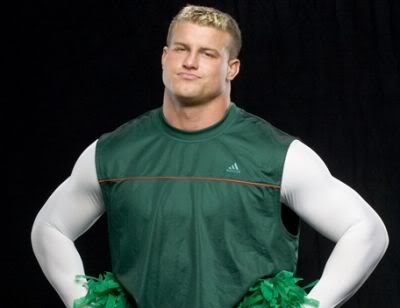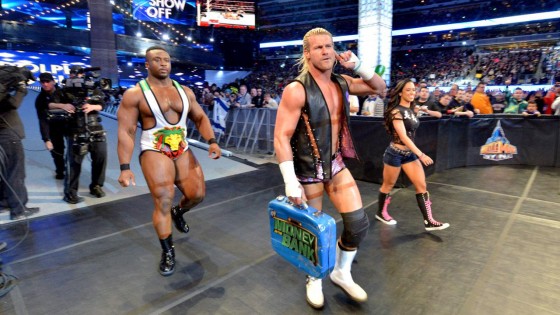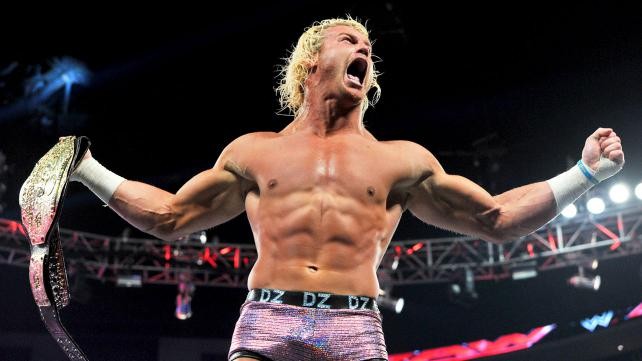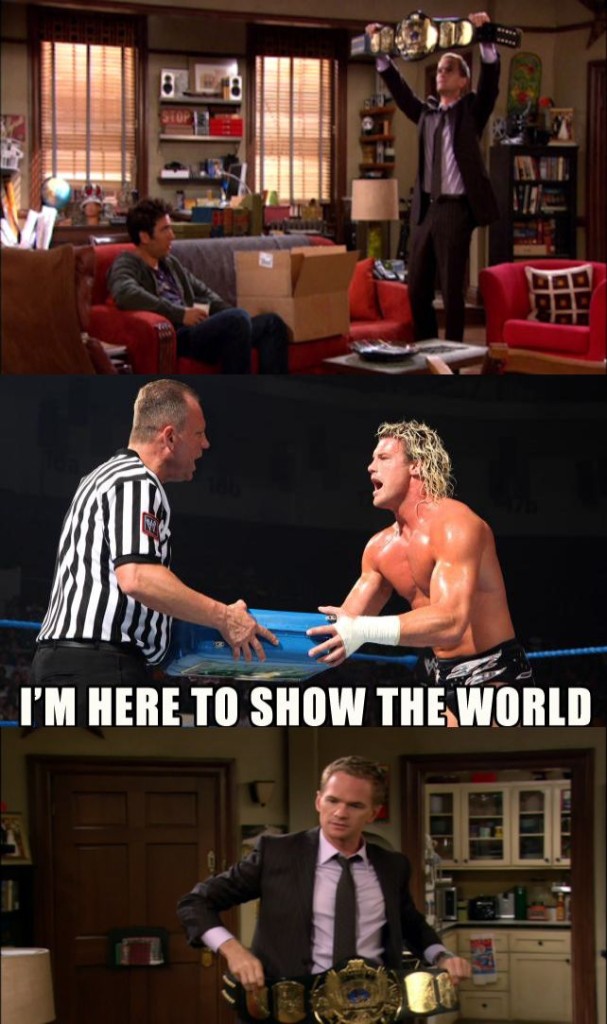Pro wrestling is a weird bastard art, and if you’re unfamiliar with its intricacies, the hordes of people in your social media circles obsessively pontificating about it every Monday night must be a truly confounding experience. Let our very own Dominic Griffin, lifelong wrestling enthusiast, teach you a little something right here, In This Very Ring…
One of my favorite lines in A Bronx Tale is when Robert DeNiro tells his son: “Nothing in this world is sadder than wasted talent.” In the world of wrestling, not everyone gets to reach their full potential. Tons of guys (and gals, for that matter) exhibit the right tools and skills for becoming a star, but fall short of reaching the top. Today, we’re going to discuss a special case in the pantheon of “wasted talent.”
We’re going to talk about Dolph Ziggler.
Nick Nemeth used to be a record-setting amateur wrestler at Kent State who longed to be a WWE superstar. In 2004, he was signed to a developmental deal. It took him three tries to make it on the roster full time. First, he debuted as an accessory to one of the most racially confusing gimmicks in wrestling, as a caddy to golfer Kerwin White, who was really Chavo Guerrero in white face. This obviously didn’t stick. Later, he was called up with a cadre of other young newcomers as The Spirit Squad, a stable of male cheerleaders. They won the tag team titles and worked some high profile feuds, but were ultimately sent back to developmental.

Nicky, the cheerleader. Gotta start somewhere… (Source: DolphZiggler.com)
Finally, he was given an opportunity to come back on the roster as a cocky, arrogant hotshot with bleached blonde hair. Dolph Ziggler was born. Ridiculous name? Of course, but it’s memorable. In professional wrestling, everything you do as an up and comer has to stand out, and everything about the Dolph Ziggler persona does just that. His Roy Batty locks, his brash behavior, his preternatural in-ring ability, it’s all a part of the package.

A cougar and her cub. (Source: Gutwrench Powerblog)
I remember my first Dolph Ziggler match. It was on an episode of Smackdown. It was not very good. I don’t remember who he faced that night, but I remember Dolph Ziggler. He had been paired with Vickie Guerrero, a heel[1] manager and mouthpiece who, after the tragic death of her legendary husband, Eddie, settled into her role as a nuclear heat magnet, eliciting boos and jeers from live crowds with exceptional aplomb. Vickie was playing the role of the cougar and Dolph, her hot, young cub. He worked a great feud with then top babyface Edge, over Smackdown‘s World Heavyweight Championship, a belt Dolph himself held for all of 11 minutes.
What stood out the most about Ziggler wasn’t his natural charisma, as it would be a few years before WWE was comfortable enough for him to let his personality shine through on the microphone, but his willingness to punish his own body to make his opponents look good.
In wrestling, the performance element of making a move or hold look painful is called selling, and few wrestlers today sell like Dolph Ziggler. You know how characters on Family Guy look when they fall? Arms flailed, limbs entwined, like pretzel corpses?
That is how Dolph Ziggler sells. Here’s a montage:
Unfortunately, one of his greatest gifts has been one of his biggest weaknesses. Being that good at making others look great has pigeonholed him through his career as a they guy to use to get other guys over. He loses on television and in pay-per-views with astonishing regularity. For a while, it seemed like he would never get to be The Guy.
Some of that was his gimmick. The way wrestlers like CM Punk broke the fourth wall to connect with fans, Dolph, on Twitter, called himself the #HEEL, a social media-ready play on wrestling alignment tropes. His cocksure attitude went from just being arrogance to him being dubbed “The Showoff,” a performer seemingly more concerned with looking good than with winning titles. As a heel, he’s never been the most effective, because he’s hard to hate. You think you should boo Dolph Ziggler because he’s an asshole and a prettyboy, but the way he sells in the ring elicits sincere sympathy on a psychological level. It’s hard to enjoy Dolph getting his ass kicked when he makes it look so good.
Here’s highlights from one of his best matches ever, with Daniel Bryan, from Bragging Rights 2010.
A similar thing happened in the mid nineties with the legendary Shawn Michaels. Here was a cocky, playboy prick who pissed fans off by cheating and betraying his friends, but slowly became a babyface because people couldn’t deny his wrestling ability. It’s hard to continuously boo a guy you love to watch.

Dolph, AJ and Big E, aka Team Rocket. (Source: WWE.com)
Mid-2012, Dolph won the Smackdown Money In The Bank match, where the winner gets a briefcase with a contract that can be turned in at any time for a world title shot[2]. This lead to a pretty fun stable with AJ Lee playing Harley Quinn to Ziggler’s Crown Prince, and newcomer Big E. Langston as the duo’s muscle. Though the group was decidedly heel, the longer Ziggler held the briefcase, every World Heavyweight Championship match started ending with “We Want Ziggler” chants. Typically, the MITB briefcase has been cashed in opportunistically, a heel interloper taking advantage of a weakened babyface champion after a match. You cash in, beat up a beat-down man, profit. Fans were so hot to see Ziggler cash in that this prolonged waiting game became a meme. Any situation where someone won something in the media would be juxtaposed with Dolph handing in that albatross of a contract, set to the opening lines of his theme song.
At Wrestlemania 29, it seemed like the right time. The fans begged for it. It wasn’t until Raw the following night that the golden moment finally happened, when he cashed in on WHC holder Alberto Del Rio.
Was the tide going to change? Was Dolph finally going to stay at the top of the card where he belonged?
Well, no. Not long after, Ziggler suffered a real life concussion, sidelining him briefly. WWE creative took this opportunity to perform a double turn with him and Del Rio in a match at Payback 2013, where Del Rio viciously turned heel by taking advantage of Ziggler’s head injury, regaining the title, but leaving a very sympathetic Ziggler in the ring as a babyface. I’ve written about this match in the past, and it’s a great one. Conventional wisdom meant that now Ziggler could chase the champion and win it back through less scrupulous means with the fans behind him, cementing himself as a true contender. That didn’t happen, though.
He lost subsequent matches for the belt and got mired in a break up with AJ and an ill-fated feud with Big E. Both of his former cohorts went on to great singles runs, while Dolph slowly fell back down the card. He continued to work really good matches (most notably a series with Antonio Cesaro on WWE’s b-programming), but stopped mattering in the grand scheme of things. Fans still cheer him when he does show up on Raw, but half the time he’s wrestling in viewer-voted or gimmick matches with Damien Sandow, another former Money In The Bank holder fallen on hard times.

Nothing says “fallen off” like meaningless trash brawls. (Source: WWE.com)
So, what happened? He’s got a great look, he sells merchandise, and is loved by the fans. Why isn’t Dolph Ziggler a top star?
Credibility is a problem. WWE uses Ziggler as a guy who loses to make other guys look strong so much that he himself is hard to take seriously as a competitor. Wrestling may be fake, but the narratives do maintain some sense of continuity. How tough would modern Batman seem in comics if you replaced Grant Morrison writing him as an endlessly resourceful badass with issue after issue of the Dark Knight coming up short? Ziggler needs to get some decisive wins over some real competitors to look like a force again.
Another is his offense. Dolph, by his nature, is a smaller wrestler who looks best on the defensive, eeking out wins by being crafty or hitting his finisher, the Zig-Zag (basically jumping on someone’s back and slamming their head backwards onto the mat) out of nowhere. As a heel, this was fine, but as a babyface, he needs a repertoire that seems threatening. Daniel Bryan is the same size, roughly, but his strikes and running knee finisher have been built up to look like legitimately destructive forces. Ziggler doesn’t have the same luck, but if he were able to use his superkick to end matches, that might change. Here he is using it to pin Randy Orton clean at Survivor Series 2012.
Finally, he needs a more concrete character. Making the transition from cocky heel to lovable babyface is difficult, especially in WWE, where the top heroes all act kind of like childish assholes, anyway. Dolph stopped cheating and being cruel to fans, but never quite made the leap to being a guy fans are 100% invested in. He’s shown glimpses of the charisma necessary to cement him as a top guy, but never sustained long enough for it to define him. Here’s a solid example of who Dolph Ziggler can be when given the time to shine.
With the influx of newer talent making a splash on the roster, a lot of people think Dolph Ziggler’s time is behind him. He’s a strong enough performer that he can feasibly have a full career in his role as a worker who puts newer guys over and enhances his opponents, like a lesser, modern day Mr. Perfect (a wrestler Dolph both resembles and emulates.)
I think there’s still time. Dolph Ziggler overcame being a caddy and a male cheerleader to get to where he was last year. This is a man who, before his WWE tryout, taped golf balls to his back and did front flips off of his car onto his driveway so he could be better at taking bumps in the ring. He studies stand-up and does open mic nights to improve his mic skills. This is a guy who will do anything it takes to be the best, and I don’t think he’s going to let the last year of setbacks get in his way.
I believe in Dolph Ziggler, and so should you.
FOOTNOTES
[1]: “Babyface” (often abbreviated to just “face”) is a term used for straight-laced “hero” type wrestlers who play by the rules. Their opposite numbers are “heels,” characters who fight dirty or behave like villains. (More fun basics like this in the first installment of In This Very Ring.)
[2]: For much of the 2000s, WWE has had a brand extension where shows Raw and Smackdown had separate rosters and therefore separate world titles, the WWE Championship and the World Heavyweight Championship. Players and titles both have swapped back and forth during annual drafts or for spontaneous storytelling reasons. In recent years, the “Smackdown title” WHC was always the secondary title, a championship more easily bequeathed to guys who were ready for the main event, but maybe not ready to be the face of the company. These belts were unified this past December.
Follow @DeadshirtDotNet and @captain_fuck on Twitter where we’ll be available to answer any possible question you could have about wrestling.




